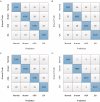Dry age-related macular degeneration classification from optical coherence tomography images based on ensemble deep learning architecture
- PMID: 39444813
- PMCID: PMC11496120
- DOI: 10.3389/fmed.2024.1438768
Dry age-related macular degeneration classification from optical coherence tomography images based on ensemble deep learning architecture
Abstract
Background: Dry age-related macular degeneration (AMD) is a retinal disease, which has been the third leading cause of vision loss. But current AMD classification technologies did not focus on the classification of early stage. This study aimed to develop a deep learning architecture to improve the classification accuracy of dry AMD, through the analysis of optical coherence tomography (OCT) images.
Methods: We put forward an ensemble deep learning architecture which integrated four different convolution neural networks including ResNet50, EfficientNetB4, MobileNetV3 and Xception. All networks were pre-trained and fine-tuned. Then diverse convolution neural networks were combined. To classify OCT images, the proposed architecture was trained on the dataset from Shenyang Aier Excellence Hospital. The number of original images was 4,096 from 1,310 patients. After rotation and flipping operations, the dataset consisting of 16,384 retinal OCT images could be established.
Results: Evaluation and comparison obtained from three-fold cross-validation were used to show the advantage of the proposed architecture. Four metrics were applied to compare the performance of each base model. Moreover, different combination strategies were also compared to validate the merit of the proposed architecture. The results demonstrated that the proposed architecture could categorize various stages of AMD. Moreover, the proposed network could improve the classification performance of nascent geographic atrophy (nGA).
Conclusion: In this article, an ensemble deep learning was proposed to classify dry AMD progression stages. The performance of the proposed architecture produced promising classification results which showed its advantage to provide global diagnosis for early AMD screening. The classification performance demonstrated its potential for individualized treatment plans for patients with AMD.
Keywords: NGA; dry age-related macular degeneration; early AMD detection; ensemble deep learning; optical coherence tomography.
Copyright © 2024 Yang, Wu, Wang, Lu, Zhao, Ding, Tang, Lu and Ma.
Conflict of interest statement
The authors declare that the research was conducted in the absence of any commercial or financial relationships that could be construed as a potential conflict of interest.
Figures









Similar articles
-
Two-step hierarchical neural network for classification of dry age-related macular degeneration using optical coherence tomography images.Front Med (Lausanne). 2023 Jul 19;10:1221453. doi: 10.3389/fmed.2023.1221453. eCollection 2023. Front Med (Lausanne). 2023. PMID: 37547613 Free PMC article.
-
Stitched vision transformer for age-related macular degeneration detection using retinal optical coherence tomography images.PLoS One. 2024 Jun 5;19(6):e0304943. doi: 10.1371/journal.pone.0304943. eCollection 2024. PLoS One. 2024. PMID: 38837967 Free PMC article.
-
Multi-scale convolutional neural network for automated AMD classification using retinal OCT images.Comput Biol Med. 2022 May;144:105368. doi: 10.1016/j.compbiomed.2022.105368. Epub 2022 Mar 2. Comput Biol Med. 2022. PMID: 35259614
-
Detection of macular atrophy in age-related macular degeneration aided by artificial intelligence.Expert Rev Mol Diagn. 2023 Jun;23(6):485-494. doi: 10.1080/14737159.2023.2208751. Epub 2023 May 5. Expert Rev Mol Diagn. 2023. PMID: 37144908 Review.
-
A SYSTEMATIC REVIEW OF DEEP LEARNING APPLICATIONS FOR OPTICAL COHERENCE TOMOGRAPHY IN AGE-RELATED MACULAR DEGENERATION.Retina. 2022 Aug 1;42(8):1417-1424. doi: 10.1097/IAE.0000000000003535. Retina. 2022. PMID: 35877964
Cited by
-
Enhanced Macular Telangiectasia Type 2 Detection: Leveraging Self-Supervised Learning and Ensemble Models.Ophthalmol Sci. 2025 Jan 13;5(4):100710. doi: 10.1016/j.xops.2025.100710. eCollection 2025 Jul-Aug. Ophthalmol Sci. 2025. PMID: 40225407 Free PMC article.
-
Multi-Modal AI for Multi-Label Retinal Disease Prediction Using OCT and Fundus Images: A Hybrid Approach.Sensors (Basel). 2025 Jul 19;25(14):4492. doi: 10.3390/s25144492. Sensors (Basel). 2025. PMID: 40732620 Free PMC article.
References
LinkOut - more resources
Full Text Sources

